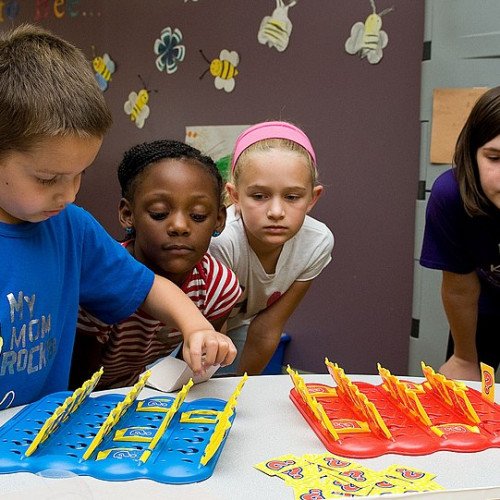GUESS WHO VS TABLUT

GUESS WHO
Guess Who? is a two-player character guessing game created by Ora and Theo Coster, also known as Theora Design, that was first manufactured by Milton Bradley in 1979 and is now owned by Hasbro. It was first brought to the UK by Jack Barr Sr. in 1982. The classic edition is currently being produced by Winning Moves Games USA. Each player starts the game with a board that includes cartoon images of 24 people and their first names with all the images standing up. Each player selects a card of their choice from a separate pile of cards containing the same 24 images. The objective of the game is to be the first to determine which card one's opponent has selected. Players alternate asking various yes or no questions to eliminate candidates, such as: "Does your person wear a hat?" "Does your person wear glasses?" "Is your person a man?" The player will then eliminate candidates (based on the opponent's response) by flipping those images down until only one is left. Well-crafted questions allow players to eliminate one or more possible cards. Special editions which have different faces have been released, including Star Wars, Marvel Comics and Disney. There are smaller, "travel" editions which have only 20 different faces. In 2008 and 2010, extra and mix and match games were released. A computer game based on the series was released in 1999 by Hasbro Interactive. In the United States, advertisements for the board game often showed the characters on the cards coming to life, and making witty comments to each other. This caused later editions of such ads to carry the spoken disclaimer line "game cards do not actually talk" in order to meet Federal Trade Commission advertising guidelines requiring full disclosure of toy features unable to be replicated with the actual product.
Statistics for this Xoptio

TABLUT
Tafl games (pronounced ], also known as hnefatafl games) are a family of ancient Nordic and Celtic strategy board games played on a checkered or latticed gameboard with two armies of uneven numbers. Most probably they are based upon the Roman game Ludus latrunculorum. Names of different variants of Tafl include Hnefatafl, Tablut, Tawlbwrdd, Brandubh, Ard Rí, and Alea Evangelii. Games in the tafl family were played in Norway, Sweden, Denmark, Iceland, Britain, Ireland, and Lapland. Tafl gaming was eventually supplanted by chess in the 12th Century, but the tafl variant of the Sami people, tablut, was in play until at least the 1700s. The rules for tablut were written down by the Swedish naturalist Linnaeus in 1732, and these were translated from Latin to English in 1811. All modern tafl games are based on the 1811 translation, which had many errors. New rules were added to amend the issues resulting from these errors, leading to the creation of a modern family of tafl games. In addition, tablut is now also played in accordance with its original rules, which have been retranslated. The term tafl (Old Norse: "table", "board"; pronounced ) is the original Norse name of the game. Hnefatafl (roughly) plausibly realised as ), became the preferred term for the game in Scandinavia by the end of the Viking Age, to distinguish it from other board games, such as Skáktafl (chess), Kvatrutafl (Tables) and Halatafl (Fox games), as these became known. The specific name Hnefatafl possibly arose as meaning "board game of the fist", from hnefi ("fist") + tafl, where "fist" referred to the central king-piece. The precise etymology is not entirely certain but hnefi certainly referred to the king-piece, and several sources refer to Hnefatafl as "King's table". In Anglo-Saxon England, the term tæfl also referred to many board games. It is not known if the Anglo-Saxons had a specific name for the game or if they generically referred to it as tæfl in the way that modern people might refer to "cards". Several games may be confused with tafl games, due to the inclusion of the word tafl in their names or other similarities. Halatafl is the Old Norse name for Fox and Geese, a game dating from at least the 14th century. It is still known and played in Europe. Kvatrutafl is the Old Norse name for Tables (the medieval forerunner of Backgammon). Skáktafl is the Old Norse name for chess. Fidchell or Fithcheall (Modern Irish: Ficheall) was played in Ireland. The Welsh equivalent was Gwyddbwyll and the Breton equivalent Gwezboell; all terms mean "wood-sense". This popular medieval game was played with equal forces on each side and thus was not a tafl variant, but rather may have been the medieval descendant of the Roman game Latrunculi or Ludus latrunculorum.